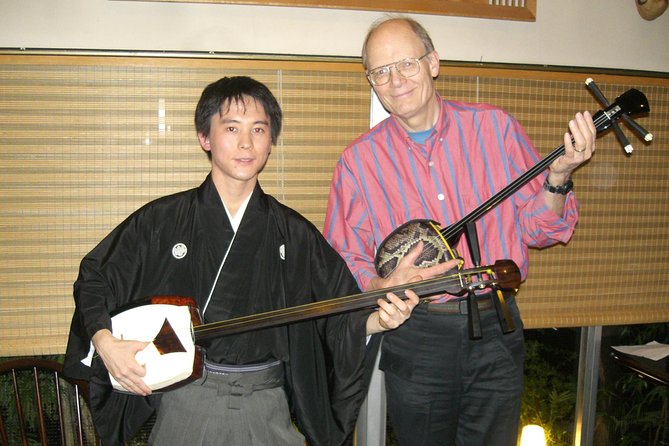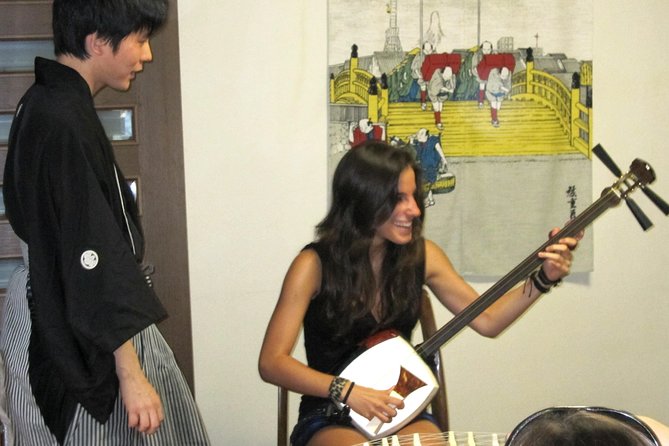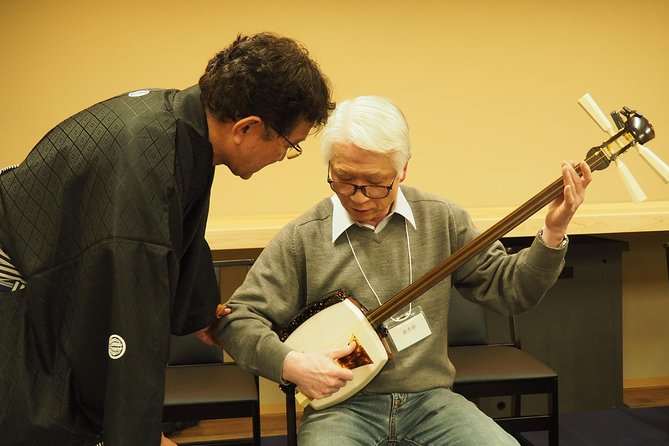The Shamisen Playing Experience offers a unique opportunity to delve into the world of traditional Japanese music. Imagine mastering the art of playing the shamisen, one of the most iconic instruments in this ancient art form.
Participants in this immersive cultural experience will learn about the instrument’s construction, the proper posture and finger movements, and the techniques required to produce beautiful music. Whether you are a seasoned musician or a curious novice, the Shamisen Playing Experience promises an enlightening and enriching journey into the heart of Japanese musical tradition.
Gain a deeper appreciation for the craftsmanship and skill involved in creating the distinct sound of the shamisen. Discover the history, significance, and techniques behind this captivating instrument and learn about the world of traditional Japanese music.
Quick Takeaways

- Finding a qualified instructor is essential for learning proper shamisen playing techniques.
- Proper posture, finger positioning, and producing different sounds and rhythms are important aspects of learning.
- Learning the shamisen requires dedication and practice to master the instrument.
- Shamisen playing encompasses both traditional and contemporary styles.
The History of the Shamisen

The shamisen has been a prominent instrument in Japanese music for centuries, evolving from its origins as a combination of Chinese and Ryukyuan instruments. This three-stringed instrument holds a significant place in Japanese culture due to its cultural significance and influence on other musical genres.
The shamisen’s distinct sound and versatility have allowed it to bridge traditional and contemporary music styles, making it a vital part of various musical compositions. Its impact can be seen in genres such as folk, classical, and even modern pop music.
Plus, the shamisen plays a crucial role in traditional Japanese theater, including kabuki and bunraku, where it provides musical accompaniment to storytelling. Its cultural significance and ability to adapt to different genres have solidified the shamisen as an essential and enduring musical instrument in Japan.
Types of Shamisen Instruments

There are three main types of shamisen instruments that are commonly used in Japanese music.
- Tsugaru Shamisen: This type of shamisen originated in the Tsugaru region of Aomori Prefecture. It has a thicker neck and a larger body compared to other types. The strings are typically tuned to a lower pitch, allowing for a deep and powerful sound.
- Nagauta Shamisen: This type of shamisen is used in traditional Japanese theater and music, particularly in kabuki and nagauta styles. It has a slimmer neck and a smaller body. The strings are usually tuned to a higher pitch, producing a brighter and more melodic tone.
- Jiuta Shamisen: This type of shamisen is commonly used in jiuta, a genre of traditional Japanese music. It’s similar in construction to the nagauta shamisen, but with a slightly wider neck. The strings are tuned to a medium pitch, balancing both the depth and brightness of the sound.
Shamisen construction involves a wooden body, usually made from paulownia or cherry wood, and a skin covering called the doukake. The shamisen is tuned using various techniques, including adjusting the tension of the strings and using bridges called koma. These tuning techniques help achieve the desired sound and tone for the instrument.
Learning to Play the Shamisen
To begin learning to play the shamisen, you can start by finding a qualified instructor. A qualified instructor will have the knowledge and experience to teach proper shamisen playing techniques. They can provide guidance on how to hold the instrument, how to position the fingers on the strings, and how to produce different sounds and rhythms.
Along With individual lessons, there are also shamisen playing workshops available where participants can learn from experts and engage in group practice sessions. These workshops offer a collaborative learning environment where players can learn from each other and receive valuable feedback.
Techniques and Styles of Shamisen Playing

A shamisen player utilizes various techniques and styles to create captivating music on the instrument. Here are four key aspects to consider when discussing the techniques and styles of shamisen playing:
-
Traditional vs. Contemporary:
Shamisen playing encompasses both traditional and contemporary styles. Traditional techniques focus on precise finger movements and rhythmic patterns, while contemporary styles incorporate innovative approaches and fusion with other genres of music. -
Fingerpicking:
One of the fundamental techniques in shamisen playing is fingerpicking. Players use their index, middle, and ring fingers to pluck the strings, creating intricate melodies and rhythms. -
Bachi Techniques:
The bachi, a plectrum or pick used to strike the shamisen strings, offers a wide range of techniques. These include striking the strings with varying degrees of force, using different angles, and employing techniques like tremolo and vibrato. -
Expressive Techniques:
Shamisen players use various techniques to express emotions and convey storytelling through their music. These techniques include slides, bends, and vibrato, which add depth and nuance to the performance.
The cultural significance of shamisen playing lies in its ability to preserve traditional Japanese music while also evolving with contemporary influences. It serves as a means of cultural expression and connects people to their roots while embracing new artistic possibilities.
Famous Shamisen Players and Performances

Famous shamisen players and their mesmerizing performances have contributed greatly to the cultural significance and evolution of this traditional Japanese instrument.
One notable figure in the world of shamisen is Masahiro Nitta. Nitta is renowned for his virtuosity and dynamic playing style, which has captivated audiences around the globe.
Another prominent shamisen player is Hiromitsu Agatsuma, known for his innovative fusion of traditional and contemporary music. Agatsuma’s performances often include improvisation and experimentation, pushing the boundaries of the instrument’s capabilities.
Plus, the Yoshida Brothers have gained international recognition for their energetic and unique approach to shamisen playing. Their fusion of traditional Japanese music with elements of rock and pop has attracted a wide and diverse fanbase.
These famous shamisen players haven’t only showcased the versatility of the instrument but also introduced it to new audiences through their captivating performances.
Shamisen in Traditional Japanese Music

One of the most integral aspects of the shamisen’s role in traditional Japanese music is its ability to convey a wide range of emotions through its distinctive sound.
The shamisen plays a significant role in traditional ceremonies, adding a touch of elegance and beauty to the proceedings. Its melodic and rhythmic qualities create a captivating atmosphere, enhancing the overall experience for participants and spectators alike.
Plus, the shamisen has had a profound influence on contemporary music in Japan. Its unique sound has been incorporated into various genres, from pop to rock, adding a traditional flavor to modern compositions. This fusion of traditional and contemporary elements showcases the versatility and enduring appeal of the shamisen as an instrument.
Modern Applications of the Shamisen

The modern applications of the shamisen extend beyond traditional Japanese music, showcasing its versatility and adaptability in various genres and artistic expressions. In contemporary music, the shamisen has found its way into a wide range of musical styles, including jazz, rock, and even electronic music. One of the most notable modern applications of the shamisen is its fusion with other instruments, creating unique and innovative sounds. This fusion allows the shamisen to blend seamlessly with instruments like the guitar, piano, and drums, resulting in a harmonious blend of traditional and modern elements. The table below provides examples of the shamisen’s fusion with other instruments in different genres:
| Genre | Instruments | Notable Artists |
|---|---|---|
| Jazz | Saxophone, Bass | Yoshida Brothers |
| Rock | Electric Guitar | Kinniku Shoujo Tai |
| Electronic | Synthesizer | Masahiro Nitta |
These examples highlight the shamisen’s ability to adapt and thrive in contemporary music, pushing the boundaries of traditional Japanese music and captivating audiences worldwide.
Frequently Asked Questions
Is the Shamisen Playing Experience Suitable for Beginners?
The shamisen playing experience is suitable for beginners, offering benefits such as learning traditional music and experiencing Japanese culture. While it may present challenges, the activity provides guidance and support to help beginners develop their skills.
Can Children Participate in the Shamisen Playing Experience?
Children of all ages can participate in the shamisen playing experience. It provides a unique opportunity for them to learn about traditional Japanese music and culture. They can develop musical skills, enhance creativity, and gain a deeper appreciation for music.
Are Musical Instruments Provided for the Shamisen Playing Experience?
Musical instruments are provided for the Shamisen Playing Experience, making it accessible to non-musicians. Participants can enjoy the opportunity to play this traditional Japanese instrument and learn the basics in a fun and engaging way.
How Long Does the Shamisen Playing Experience Typically Last?
The shamisen playing experience typically lasts for about one hour. During this time, you will have the opportunity to learn various shamisen playing techniques and discover the benefits of learning this traditional Japanese instrument.
Is Prior Musical Experience Required to Participate in the Shamisen Playing Experience?
Prior musical experience is not required to participate in the shamisen playing experience. Beginners can benefit from learning the shamisen as it offers a unique opportunity to explore traditional Japanese music and culture.
The Sum Up
To sum it up, the Shamisen Playing Experience provides a unique opportunity for individuals to delve into the rich history and intricate techniques of traditional Japanese music.
By learning about the construction and significance of the shamisen, participants can gain a deeper appreciation for the craftsmanship and skill required to master this iconic instrument.
Whether you’re a seasoned musician or a curious novice, this experience promises to be an enlightening and enriching journey into the heart of Japanese musical tradition.





